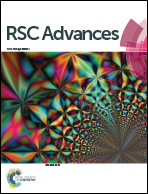p-BiOI/n-SnS2 heterojunction flowerlike structure with enhanced visible-light photocatalytic performance†
Abstract
A BiOI/SnS2 p–n junction is prepared by depositing BiOI particles on flowerlike SnS2 flakes. The heterojunction formed between p-type BiOI and n-type SnS2 brings greatly improved photocatalytic activity compared with pure SnS2 or BiOI in the degradation of Rhodamine B dye under visible light and sunlight irradiation. The improved photocatalytic performance is explained by the synergetic effects of the formation of a p–n junction between BiOI and SnS2. The migration of photogenerated carriers can be promoted by the electric field established at the heterojunction interfaces, leading to effective separation of the photogenerated electron–hole pairs and reduced electron–hole recombination. The BiOI/SnS2 heterojunction will find promising applications in photocatalysis and solar energy conversion.


 Please wait while we load your content...
Please wait while we load your content...